Shopify vs Etsy: What’s the Difference and Which Should You Use?
If you’re here reading this, then it means you want to start selling online but can’t figure out which platform is right for you. You’ve probably narrowed your options down to Shopify vs Etsy and are about to make your decision. Good news! You are in the right place because what you will see next is an extensive comparison of the two eCommerce platforms.
In this post, we’ll talk about the differences between Shopify and Etsy in terms of features, ease of use, pricing, extra fees, and design. You will also learn what kind of products you can sell on each platform and what services you can use to increase sales in your online shop.
Let’s dive in.
Why Shopify vs Etsy?
Before jumping to the facts, you might wonder why we’re comparing Shopify vs Etsy specifically. Since this post is geared towards individuals or small businesses that need a platform to start selling online, Etsy and Shopify are some of the most effective and popular platforms for people who make their debut in the eCommerce realm.
If you’ve never sold products online before, you might want to look into these two platforms because they are beginner-friendly and easy to set up. But, depending on your needs, you will notice how different they are in terms of target audiences, setup processes, costs, and customization.
Shopify vs Etsy: Which one is the best for you?
After this brief introduction, let’s get to the part where we compare Shopify and Etsy head to head. Next, we’ll be breaking down all the important aspects that make the two platforms distinctive. But even though they are different, you’ll stumble upon similarities, too.
So, how is Shopify different from Etsy? Let’s find out by comparing the following:
1. Features
In this section, we’ll talk about all the features that Shopify and Etsy bring to you and what kind of products you can list on these sites.
Here’s a quick summary:
| FEATURE | SHOPIFY | ETSY |
|---|---|---|
| Platform type | Online store website | Marketplace |
| Unlimited products |  |  |
| Custom domains |  | via URL redirect only |
| Third-party integrations |  |  |
| Dropshipping |  |  |
| Templates | 80+ | 10+ |
| Marketing tools |  |  |
| Analytics and reports |  |  |
| Blog module |  |  |
| Payment methods | Shopify Payments, Apple Pay, Amazon Pay, Google Pay, PayPal, Shop Pay | Credit/debit card, PayPal, bank transfer, Apple Pay, Google Pay, local banking services |
| Extra fees on | Subscriptions, credit card transactions, third-party payment methods | Subscriptions, transactions, listings, shipping, payment processing, POS, optional fees |
| Currencies | 130+ | 30 |
| Selling languages | Up to 20 | 10+ |
| Support | 24/7 | 24/7 |
Website builder vs marketplace
First of all, it is necessary to specify the essential difference between Shopify and Etsy. Shopify is a website builder, while Etsy is a marketplace. What does this mean?
A website builder puts at your disposal all the tools and functionalities that you need to create your own eCommerce website. If you choose Shopify, you must create a website in order to be able to sell your products.
There’s an alternative to it, though. If you already have a business website or blog, you don’t have to build a new one from scratch. Instead, you can use Shopify to create different sales channels that you can share with your customers, such as adding “Buy buttons” to your existing websites. For that, you only need the Shopify Lite plans.
Etsy, on the other hand, is a marketplace, which is a place where you create an account and simply start selling products. Apart from being able to customize your dashboard and store front-end, you don’t need to build anything or create a separate website.
All you have to do on Etsy is to create an account and set up your shop. Setting up a shop is easy; Etsy guides you very well through the steps. Throughout the process, you need to fill out your shop preferences (such as name, country, language), add your first listing, set up your bank details (where you will get paid), and enter the billing details.
What products can you sell on Shopify vs Etsy?
Shopify and Etsy differentiate by the kind of products that you can sell. While Shopify has a broader palette of product types (you can sell almost anything as long as you follow Shopify’s Use Acceptable Policy), Etsy targets specific vendors. Etsy is a marketplace that focuses on handmade/vintage items and craft supplies/tools.
On both Shopify and Etsy, you can sell unlimited physical and digital products. But there are some costs you need to cover. For example, you need to buy a plan to use Shopify’s services (pricing starts at $9 per month), while Etsy is free to use but charges $0.20 per listing, plus many other fees. More on the costs of selling on Shopify vs Etsy later.
Products
As for adding products to your shop, here’s another table that summarizes everything you need to know about the conditions and limitations of how you can showcase products on Shopify vs Etsy:
| FEATURE | SHOPIFY | ETSY |
|---|---|---|
| # of products | Unlimited | Unlimited |
| Variations |  |  |
| Shipping |  |  |
| Digital products |  |  |
| Personalization | via third-party integration |  |
| Listing free | $0 | $0.20 |
| Media (images, videos) |  |  |
| On-page SEO |  |  |
| Discount codes & gift cards |  |  |
When it comes to your product pages in practice, they can be made to look very similar on both platforms. The classic eCommerce look is something we’ve gotten used to over the years.

Custom domains
As for custom domains, the process is faster on Shopify because the basic plan offers the possibility to use your own domain. On Etsy, however, you can only benefit from a custom domain if you already have a website and redirect the URL to your Etsy shop. Or, you can just buy a domain from a domain name generator, like Domain Wheel, and redirect it to Etsy.
Currencies, languages, and sales channels
Shopify is available in up to 20 languages, which means that you can translate your online shop to match your audience’s language preferences. As for the currencies, Shopify also leaves room for flexibility to its users by offering a palette of 130+ currencies.
If you want to sell on Shopify via other channels than your own website, you can choose from a handful of sales channel alternatives. They include a shop app for Android and iOS users, Facebook, Instagram, Buy Buttons to integrate Shopify with your current website (no matter what platform you use), Google, Messenger, Wholesale, and Handshake.
Etsy is more limited than Shopify in this matter. It is available in 10+ languages and 30 currencies. For instance, if you’re selling from the EU, the default currency will be EUR and not your country’s currency (if you have a different local currency). This means that the prices displayed next to your products will be in EUR and you’ll be charging people in EUR as well.
When it comes to the variety of sales channels, Etsy does let you expand your network, too. If you go to your dashboard’s Shop Manager → Sales Channels → Etsy, you will find multiple selling methods to integrate with Etsy.
Dropshipping
Etsy and Shopify are both capable of handling a dropshipping operation.
You can set up your store in a way so that you don’t hold any inventory or don’t even touch your products before selling them.
If you’re not sure what dropshipping is and how it works, here’s a guide on how to start a dropshipping business. It covers the whole process in detail.
Integrations
Shopify comes with an app store where you can look for extra functionality to add to your online store. There, you will find apps made by the Shopify team and also third-party tools that you can integrate with your Shopify setup. Just search for what you need and you will get tens of recommendations for each query. You can even integrate Shopify with Etsy.
Etsy is also flexible when it comes to integrating it with third-party apps and tools. You just need to go to your Shop Manager and click on Integrations. There, you will see tens of available apps for improving your Etsy store’s functionality. If you want to add more, you can use a tool like Automate.io and finish the job in minutes.
2. Ease of use
Let’s talk a bit about how easy it is to sell on Shopify vs Etsy. The onboarding is intuitive on both platforms in the sense that you just need to follow the steps, after which your store goes live and is ready to sell products.
In Shopify, you first sign up for the plan you want and then follow the setup process. Answer a few questions, add your personal details, and enter your store name. That’s it for the setup!
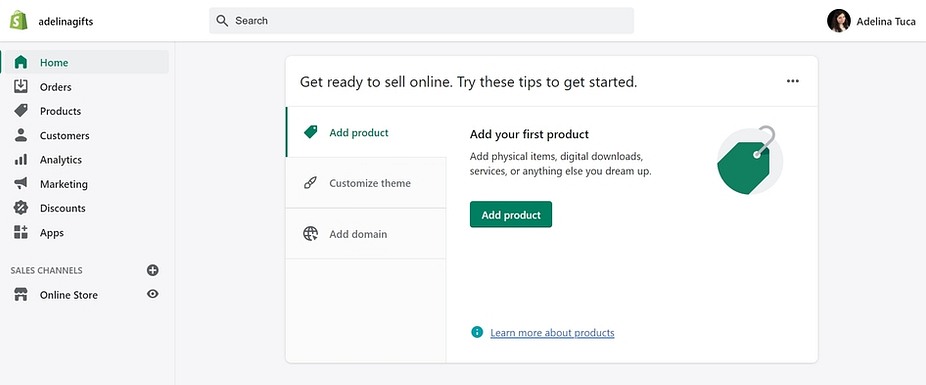

Now that your store is live, it’s time to add your first products. The interface is very easy to use, intuitive for all kinds of users, and has a modern look. Anything you need to fill in is in there as the platform guides you through all the important aspects of how to start selling online.
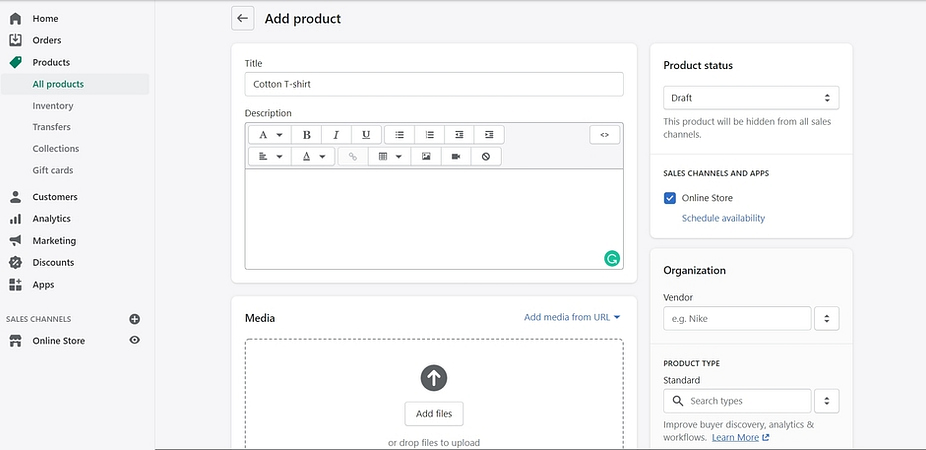
Start by adding your products, customizing your design, and adding a domain. You can also store your customers’ data, add gift cards, track orders, check site analytics, and set up marketing campaigns. All in a very intuitive interface. Nothing seems unclear in Shopify.
Much of the sign-up process with Etsy is very similar. You start by creating an account which is needed to launch your store. You are required to provide all the payment and billing details right from the get-go, along with shop preferences.
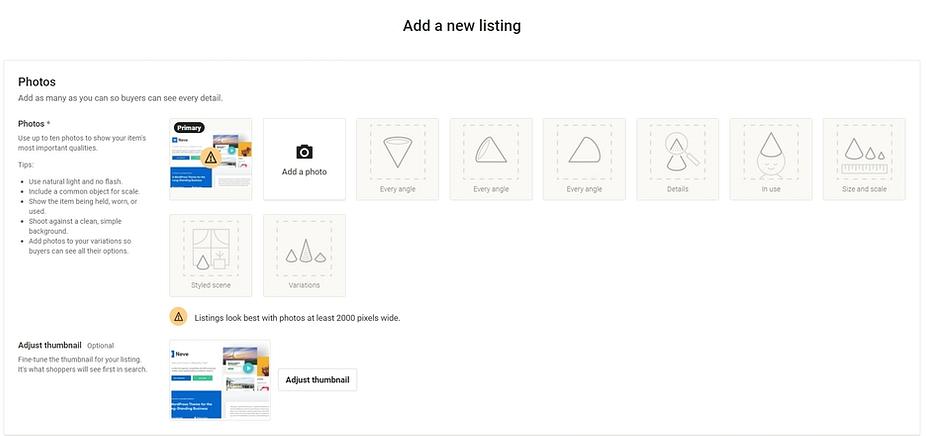
Once the store is up, you can start adding as many listings as you want. Make sure to set up all the essential details for each listing, such as shipping costs, descriptions, pictures, inventory, categories, etc. Everything is easy to do via Etsy’s intuitive interface.
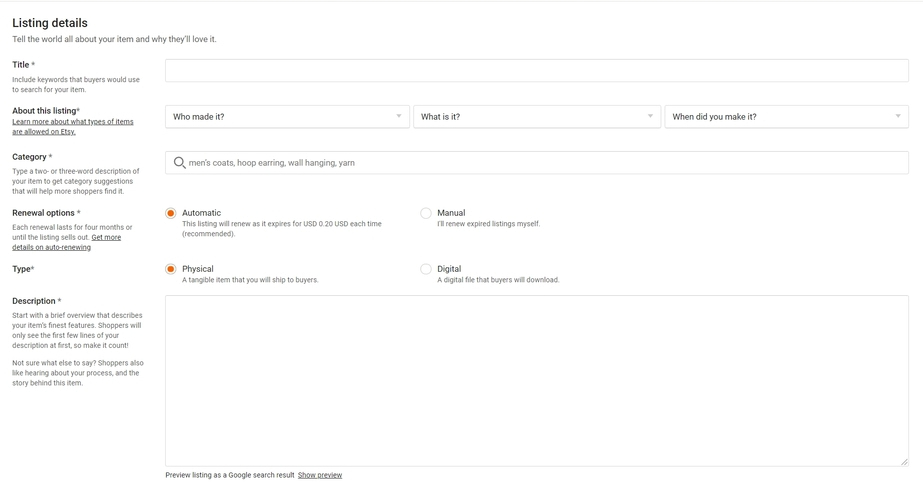
On the shop page, you can also describe your business, set shop policies using Etsy’s pre-made templates, upload banners, add discounts, and create marketing campaigns (SEO, advertising, social media optimization, communities, and more).
3. Design
Shopify is more flexible because it provides a library of themes (free and premium) that you can choose from to match your shop’s purpose.
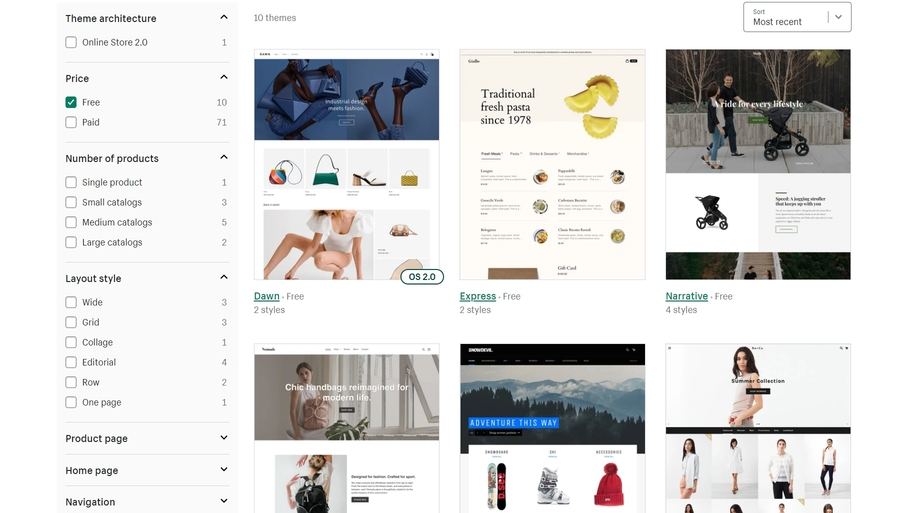
Etsy, despite being a marketplace and not a website builder like Shopify, lets you customize your shop’s layout too, through the Patterns feature, which are basically design templates.
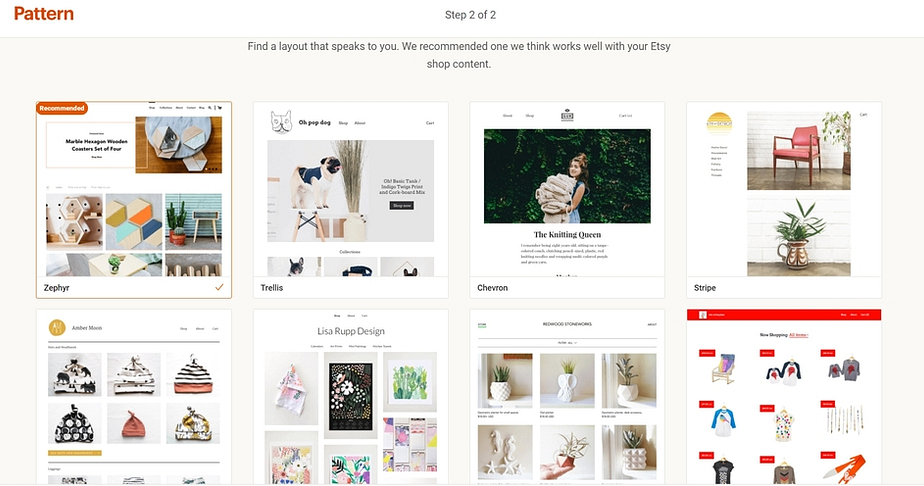
Apart from the designs, the difference between Shopify and Etsy here is in the number of design options that each platform offers. Shopify comes with over 80 diverse templates, while Etsy provides 10 templates.
You can customize your Shopify and Etsy shops via a dedicated dashboard that both platforms provide.
4. Extra fees and costs
Shedding some light on this section before talking about the costs – the costs and fees do not involve the pricing plans of Shopify or Etsy. It is about all the extra fees you need to swallow based on the kind of services you have enabled in your store.
So, here’s how much you must pay additionally to sell online on Shopify vs Etsy:
Shopify
Shopify plans come with a few extra fees – credit card and transaction fees that apply in the following contexts (these numbers are for the US only and vary by country):
- Online credit card fees – 2.9% + 30¢ USD
- In-person credit card fees – 2.7% + 0¢ USD
- Transaction fees when not using Shopify Payments – 2.0% of every sale
Let’s clarify what these transaction fees mean. Shopify comes with an integrated payment system – Shopify Payments – which you can use on your site to avoid extra fees. Shopify Payments is not available in all countries yet, so you will have to integrate Shopify with a third-party payment gateway if that’s the case for you. And as you’ve seen above, if you’re not on Shopify Payments, you have to pay an additional fee on your sales.
Etsy
As far as Etsy goes, here are the fees that you have to pay when selling on the platform:
- Listing fees – $0.20 for each product/item that you list on the site or on Etsy’s mobile apps. A listing expires after four months, which requires another $0.20 every time you want to renew it. If you list multiple variations of the same product, you won’t be charged per listing, but you will be charged an extra $0.20 if someone purchases one more variation of that given product.
- Transaction fees – 5% of the total sum between your product’s price + the amount you charge for shipping, gift wrapping, and personalization fees. This applies to every sale you make on Etsy.
- In-person selling fees – $0.20 transaction fee if you do not use the Square reader to process payments for in-person sales. If you sync your Etsy listings with Square, you will be charged a different fee – this time for using the Square reader.
- Shipping fees – 5% of the total shipping cost if you charge the customer with a separate shipping fee.
- Payment processing fees – Etsy charges a fee for each transaction made via Etsy payments. It usually varies based on your country and bank account, and it’s calculated from the total price of the item, shipping fee, and other applicable sales taxes.
5. Pricing plans
We’ve talked about all kinds of fees that Shopify and Etsy charge for using their services, but that’s not all you need to know about the financial aspect. Each eCommerce platform has pricing plans that unlock more features and options for your business.
Let’s have a look at the Shopify vs Etsy pricing plans:
Shopify pricing plans
- Shopify Lite – $9 per month (if you do not want to create a website)
- Basic Shopify – $29 per month (for eCommerce businesses that are just starting out)
- Shopify – $79 per month (for growing businesses that have both an online presence and physical store)
- Advanced Shopify – $299 per month (for scaling businesses that need advanced reporting and selling strategies)
- Shopify Plus – $2,000+ per month (enterprise solutions for high volume of sales)
If you want to read more on the differences between Shopify’s pricing plans, we’ve covered everything in this post. You’ll learn what you get if you pay more and what the pros and cons of each plan are.
Etsy pricing plans
- Standard – $0 (but you still need to pay the extra fees that we mentioned above)
- Plus – $10 per month (includes advanced shop customization, discounts, restock requests, and credits for various marketing services)
Shopify vs Etsy conclusion: Which one to choose?
This sums up our Shopify vs Etsy comparison. We know that it’s not easy to choose the perfect platform for your eCommerce business because there is no platform that ticks all the boxes. So, if you’re still undecided, here’s our summary table once more to refresh your memory:
| FEATURE | SHOPIFY | ETSY |
|---|---|---|
| Platform type | Online store website | Marketplace |
| Unlimited products |  |  |
| Custom domains |  | via URL redirect only |
| Third-party integrations |  |  |
| Dropshipping |  |  |
| Templates | 80+ | 10+ |
| Marketing tools |  |  |
| Analytics and reports |  |  |
| Blog module |  |  |
| Payment methods | Shopify Payments, Apple Pay, Amazon Pay, Google Pay, PayPal, Shop Pay | Credit/debit card, PayPal, bank transfer, Apple Pay, Google Pay, local banking services |
| Extra fees on | Subscriptions, credit card transactions, third-party payment methods | Subscriptions, transactions, listings, shipping, payment processing, POS, optional fees |
| Currencies | 130+ | 30 |
| Selling languages | Up to 20 | 10+ |
| Support | 24/7 | 24/7 |
If you ask me, I would conclude the comparison this way:
If you’re planning to start a standalone online store – a store that’s on your own domain name – which you can personalize and grow however you wish, then Shopify is for you. The great thing about Shopify is that it gives you the keys and lets you do pretty much whatever you wish, while also taking care of the technical aspects of the whole project under the hood. As in, you really don’t have to worry about anything apart from selling and growing the business.
If you are an occasional seller who doesn’t have concrete eCommerce business plans, then you can test the market with Etsy. You can open your own shop, list your handmade products or whatever else you want to sell, and get those listings in front of people right from day one. The great thing about Etsy is that potential customers are already there, actively browsing the marketplace, searching for things to buy.
Do you have any questions about Shopify vs Etsy? Let us know in the comments section below!








Post a Comment